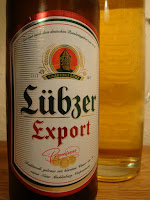 Lübzer Export is really quite a pale, straw-yellow beer with lots of carbonation feeding a desnse white head. The aroma is sweet, bready, with a light touch of resinous hops and a twist of lemon. The flavour is surprisingly malty up front, with bready notes as evident on the nose, and a suggestion of saltiness and lime. The hops are subtle, but give a nice enough grassy, herbal counterpoint to the malts. With a medium body, it goes down quite well, finishing somewhat dry with a hint of spice. It's perhaps a little watery as you go down, but in fairness, it's a straightforward, decent enough beer, and at 5.2% ABV is a touch higher than most lagerbiers, and I began to wonder if it was truer to what people think of as being export, what with the breadiness, stronger malts and a little more alcohol.
Lübzer Export is really quite a pale, straw-yellow beer with lots of carbonation feeding a desnse white head. The aroma is sweet, bready, with a light touch of resinous hops and a twist of lemon. The flavour is surprisingly malty up front, with bready notes as evident on the nose, and a suggestion of saltiness and lime. The hops are subtle, but give a nice enough grassy, herbal counterpoint to the malts. With a medium body, it goes down quite well, finishing somewhat dry with a hint of spice. It's perhaps a little watery as you go down, but in fairness, it's a straightforward, decent enough beer, and at 5.2% ABV is a touch higher than most lagerbiers, and I began to wonder if it was truer to what people think of as being export, what with the breadiness, stronger malts and a little more alcohol. So how would the Lübzer Pils compare? Well, I clearly wasn't very inpressed by it, as my notes just wander off and do something less boring instead. It has little aroma, but what is there provides slight citric notes. The flavour is bready, and doesn't provide much hop bitterness at all, being more like the grassy, herbal notes I got with the Export. Not what I would think of as being a classic example of northern German pils, although it does meet the regulation 4.9% ABV. To answer my own question though, it did not compare well...
So how would the Lübzer Pils compare? Well, I clearly wasn't very inpressed by it, as my notes just wander off and do something less boring instead. It has little aroma, but what is there provides slight citric notes. The flavour is bready, and doesn't provide much hop bitterness at all, being more like the grassy, herbal notes I got with the Export. Not what I would think of as being a classic example of northern German pils, although it does meet the regulation 4.9% ABV. To answer my own question though, it did not compare well... And so on to the Lübzer Bock, an altogether different beast at 7%, with a ruddy brown complexion, and a tan head that dissipates quickly. It smells bock-like, delivering that sweet, malty undertone, but also with some fruity notes and a fair dose of toastiness. This all comes though in the taste too, as it's certainly malty-sweet, not too sugary, thankfully, with toasted bread and a muted berry-like fruitiness. The finish does strange things though, as it's cut with a strange, almost bitter-almond in the finish. It goes like this: take a mouthful, feel malty sweetness as described above. Swallow, and you get berries and apples. Don't take another mouthful, but swallow again, and burnt toast and almonds appear along with a creeping alcohol warmth. Repeat till glass is empty. I don't think I've ever had such a well-defined three-way split in flavours appearing in stages. Not a bad bock at all.
And so on to the Lübzer Bock, an altogether different beast at 7%, with a ruddy brown complexion, and a tan head that dissipates quickly. It smells bock-like, delivering that sweet, malty undertone, but also with some fruity notes and a fair dose of toastiness. This all comes though in the taste too, as it's certainly malty-sweet, not too sugary, thankfully, with toasted bread and a muted berry-like fruitiness. The finish does strange things though, as it's cut with a strange, almost bitter-almond in the finish. It goes like this: take a mouthful, feel malty sweetness as described above. Swallow, and you get berries and apples. Don't take another mouthful, but swallow again, and burnt toast and almonds appear along with a creeping alcohol warmth. Repeat till glass is empty. I don't think I've ever had such a well-defined three-way split in flavours appearing in stages. Not a bad bock at all.I should point out also that none of these beers make use of hop extract, which I think is almost unusual in Germany for a brewery of that size.
2 comments:
Some day, we'll be the last people who remember Why Don't You..?
Do you get many German bocks that dark, which don't actually claim to be dunkles?
Yes, I've been trying to forget, but it keeps slipping out... As do Andy Pandy references!
To be honest, I'm not sure. I tend not to go for Bocks very often, but I've had a few Bocks, like the Einbecker, that are definitely dark, however in that case they add a Dunkel qualifier as there's a Helles version also. But there's also the other ones here, only the Andechser Doppelbock Dunkel contains the Dunkel qualifier as there is also a helles version as I recall, while the Mönchshof Bockbier is definitely dark but feel no need for the qualifier.
I just realised I haven't posted notes on the other boacks I tried earlier this year. I bought a mix of them, so will have to look.
Post a Comment